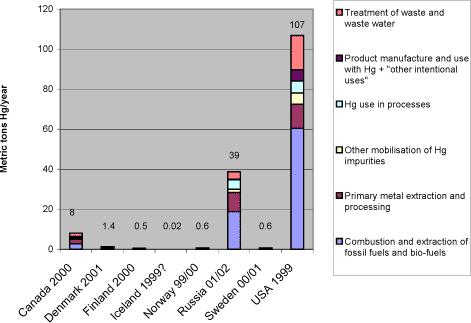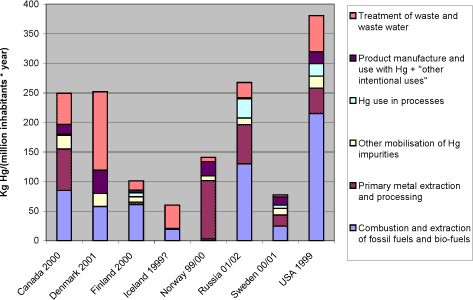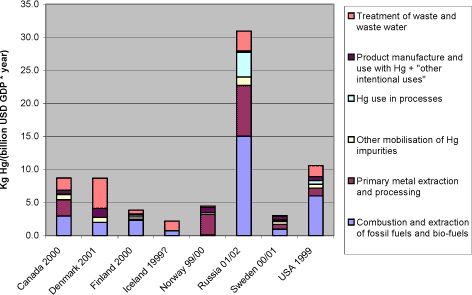|
Arctic Mercury Releases Inventory 1 Executive summary1.1 This inventory report 1.1 This inventory reportThe AMAP Assessment reports (AMAP 1997, 1998, 2002) have evaluated the available information on selected pollutants and their effects in the vulnerable Arctic environment. In the `AMAP Report on Issues of Concern' update presented in 2000 (AMAP, 2000), mercury was highlighted as an `issue of concern'. This report confirmed the presence of significant levels of mercury in the Arctic environment, and identified a mechanism by which elemental mercury, previously thought to be of little biological significance, is converted in the Arctic to a reactive form which can accumulate in biota. It also reported studies in the Arctic that documented subtle effects on infant neurodevelopment and blood pressure from exposure to mercury during pregnancy, implying that infants may be at risk for similar effects in several parts of the Arctic. “Noting with concern that releases of mercury have harmful effects on human health and may damage ecosystems of environmental and economic importance, including in the Arctic” the Arctic Council Ministers, in 2000, “called upon the United Nations Environment Program to initiate a global assessment of mercury that could form the basis for appropriate international action in which the Arctic States would participate actively”. Furthermore, they agreed to take a lead in addressing this issue in the Arctic countries, by initiating a project aimed at reducing the anthropogenic releases of mercury from these countries. The project was implemented under the Arctic Council Action Plan to Eliminate Pollution of the Arctic (ACAP) with Denmark as project co-ordinator. This report is part of the ACAP Mercury project. The objective of the report is to present and analyse compiled data on mercury releases from the Arctic countries, summarise existing initiatives to reduce mercury releases, and propose options for further release reductions. The report has been prepared primarily on the basis of the Arctic countries' responses to a questionnaire on mercury releases, uses and wastes. It should be noted that the data from the Russian Federation were extracted from the report "Assessment of Mercury Releases from the Russian Federation", also prepared as part of this ACAP project (ACAP 2004), because official response to the mercury questionnaire from the Russian Federation has not yet been received. In addition, relevant information from various other recent national and international compilations and studies has been included in the report preparation. This document presents mercury data which for some countries have been newly updated, partly inspired by - and prepared for the needs of - this study. For other countries, the submitted mercury data have been prepared and reported in other, previous inventories. All in all, the Arctic countries have explored virtually all options for mercury release reductions during the last three decades or more. There is a solid basis for mutual inspiration between them, and in a wider perspective, to other countries of the world. The release reduction options presented in this document are based on this common data base of experiences. This also implies that strategies or actions to pursue these options are already on the way in many of the countries. Though mercury releases from the Arctic countries are still of significance, the data of this report should be seen in the light of the mentioned reductions achieved in many of the countries. Examples of reductions achieved so far are given for a couple of countries in the description of their respective mercury reduction efforts in section 6 of the report. The questionnaire methodology has provided a thorough basis for the responding countries to enhance comparability and transparency. Naturally, however, the countries have used their available estimates as background data, and the methods for estimation of these existing data have been quite different. The same is likely the case with the handling of data uncertainty. Thus, when comparing national release data, conclusions should be drawn with some caution. Newer the less, the compilation of data from the Arctic States does provide very interesting indications of which sources are the major ones across the Arctic countries, as well as of similarities and differences in the national mercury release source patterns. A general introduction to mercury release sources and a conceptual model illustrating its cycling in the biosphere is given in section 3.1. 1.2 Summary of inventory resultsSection 3 presents the results of this inventory on an overview level. According to the reported release data, USA has the responsibility of managing by far the largest amounts of mercury to the atmosphere among the Arctic countries. The Russian Federation comes second, while reported atmospheric releases from Canada and the smaller reporting countries are considerably lower, see figure 1-1. In this national perspective, it must be remembered that large parts of all the countries are situated outside the Arctic region it self. This means that only parts of their reported mercury releases have direct, local influence in the Arctic. Yet, according to the current understanding, mercury has a high residence time in the atmosphere (once emitted), and is therefore transported hemispherically or even globally (UNEP, 2002). This means that mercury releases originating outside the Arctic region it self may have significant influence on the mercury loads in the region, and releases from the whole area of all the Arctic countries are therefore relevant in the Arctic perspective. Figure 1-1 Reported national atmospheric releases in metric tons/year (data from questionnaires and ACAP, 2004 of this study).*1
Notes: *1: Comparisons among totals reported for the different countries should be made with caution, since the reported data for each country have differing levels of associated uncertainty, see section 2.2.3. Figure 1-2 shows, that in terms of atmospheric mercury releases per inhabitant, the countries are much more equal, yet some differences still appear. It should be noted that these figures may be quite vulnerable to uncertainties on estimates and differences in estimation methods between countries. Figure 1-2 Reported atmospheric releases in kg mercury/year per million inhabitants, by country (data from questionnaires and ACAP, 2004 of this study).*1
Notes: *1: Population and GDP data from CIA's World Fact Book (accessed in summer 2003 at: http://www.odci.gov/cia/publications/factbook/index.html). Comparisons among totals reported for the different countries should be made with caution, since the reported data for each country have differing levels of associated uncertainty, see section 2.2.3. The overall source categories contributing with largest atmospheric mercury releases are:
As an alternative normalisation basis, reported atmospheric mercury releases per GDP (Gross Domestic Product) in billion US Dollars are shown in figure 1-3. An important factor in this equation is of course the GDP per inhabitant ratios which are currently much lower in the Russian Federation than in the other Arctic countries, but are expected to rise in the near future. Figure 1-3 Reported atmospheric releases in kg mercury/year per GDP in billion US dollars, by country (data from questionnaires of this study).*1
Note: *1: Population and GDP data from CIA's World Fact Book (accessed in summer 2003 at: http://www.odci.gov/cia/publications/factbook/index.html). Comparisons among totals reported for the different countries should be made with caution, since the reported data for each country have differing levels of associated uncertainty, see section 2.2.3. 1.3 Discussion of major source typesIn section 4 the major source categories are discussed in more detail. For each category, the project data are analysed briefly, selected current release reduction initiatives are outlined, and possible options for further reductions are listed. Most of the options are well known in many of the Arctic countries, and are in many cases already under consideration, planning or implementation in one or more of the countries (see also section 6). This does, however, not make them less relevant in this presentation, as the results of this inventory confirms their relevance and stresses that the reduction measures should be pursued further, if mercury release reductions are wanted. Below, the suggested options for further mercury release reductions for each major source category are listed briefly. Here in the executive summary, it was chosen to focus on the suggested options; the background for the suggestions is given section 4. A broader overview of existing mercury release reduction plans/strategies in the Arctic Countries, national as well as regional, is given in section 6. 1.3.1 Combustion of coalAtmospheric emission reduction systems
Coal washing
Choice of energy sources
Reduction of energy consumption
1.3.2 Non-ferrous metal productionAtmospheric release reduction measures
Releases to other media, and releases from extraction residues
1.3.3 Waste treatmentThe following options could be considered as parts of an integrated approach:
1.4 Discussion of other selected sourcesMercury-based chlor-alkali production:
Mercury contamination from gold extraction in the Russian Federation Extensive mercury use through centuries and secondary gold extraction from tailings represent major environmental risks. Oil and gas extraction A significant source in some regions - warrants more attention in inventories and release control. Dental amalgam One of the last major product uses in the Arctic countries. Stronger incentives to consumers for choosing alternatives are needed. Laboratory chemicals An example of a mercury application where international co-operation could promote use of new mercury free standards. Development of a "Least essential uses" elimination procedure An option for enhancing substitution of uses where mercury-free alternatives are readily available.
|


